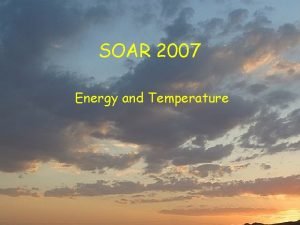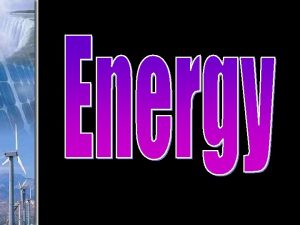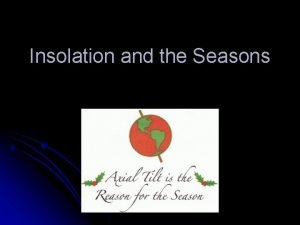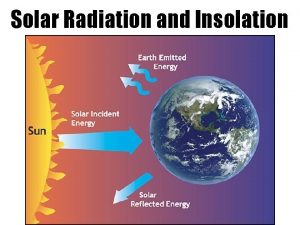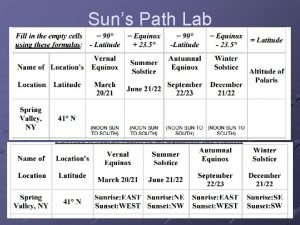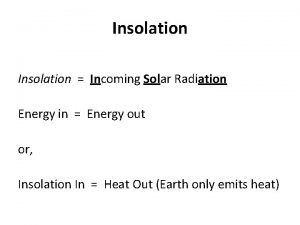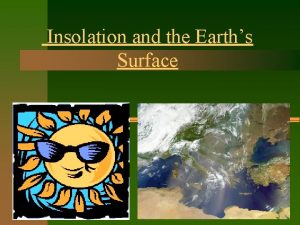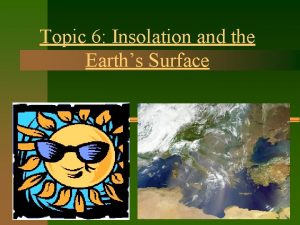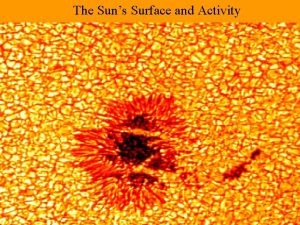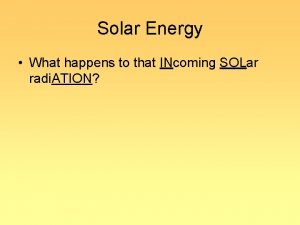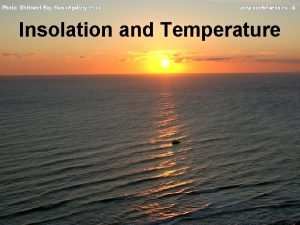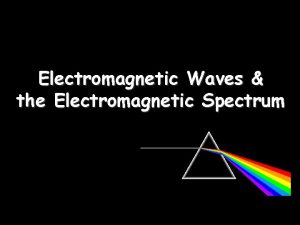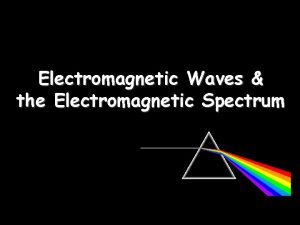INSOLATION INcoming SOLar radi ATION the suns electromagnetic






















- Slides: 22

INSOLATION INcoming SOLar radi. ATION = the sun’s electromagnetic energy that reaches the Earth.


The Sun’s strength or intensity depends on three factors: 1. Angle of insolation 2. Duration of insolation 3. Type of surface it strikes

Angle of Insolation Measurement from horizon up to position of Sun. n Relationship – the higher the sun is in the sky the greater the angle overhead=> noon sun has greatest angle of insolation n Relationship – the greater the angle, the more intense the rays are (summer) - the lower the angle, the more spread out the rays are (winter)


Duration of Insolation n. Length of time the sun is up. n. Relationship: longer duration of insolation, higher the temperature (more intense) n. Varies with latitude


Where are we and how much are we getting right now? Autumnal equinox Fall in the northern hemisphere n Winter solstice Winter in the northern hemisphere n

Vernal Equinox Spring in the northern hemisphere n Summer solstice Summer in the northern hemisphere n

Absorption of Insolation Only 50% of the sun’s energy is absorbed by Earth’s surface. n Rest is reflected, scattered or absorbed by the atmosphere. n The absorption of heat energy from the sun depends on the specific heat of the substance. n Land has a lower specific heat, so takes less time to heat up, while water has a higher specific heat, thus taking more time to heat up. n

Color or structure of surface also determines if heat will be absorbed or reflected In general, light colored surfaces reflect n While dark colored surfaces absorb n Incoming energy from the sun: UV, visible and infrared Outgoing energy from Earth: terrestrial radiation – infrared.

INSOLATION WRAP-UP Angle of insolation = how high sun is in sky. n Measured from the horizon (position of the sun) => greatest angle = ______ n Changes with the seasons – in Northern Hemisphere: Lowest noontime angle =December 21, winter solstice Highest angle =June 21, summer solstice n As angle of insolation increases and duration of insolation increasestemperature increases. n Most energy gets to Earth’s surface as visible light. n Ozone absorbs high energy radiation n Infrared radiation is absorbed by water and carbon dioxide. n n A substances reflectivity = albedo

Four Reasons water and land temperature differ: Water has a higher specific heat. n Water reflects low angle insolation better. n Water is transparent => insolation penetrates more deeply, more quickly. n Convection currents carry heat energy into hydrosphere => land heats faster than water and land cools faster than water. GOOD ABSORBERS ARE GOOD RADIATORS n

Insolation – Temperature Lag n n n A time lag exists between time of greatest intensity and time of highest air temperature. WHY? Ex. June at noon – Earth receives most solar energy but highest temperature is later. Because temperature depends on the balance between incoming energy and energy lost. Even after maximum insolation, Earth continues to receive more energy than lost => temperature continues to rise during this ‘lag’ period. Following balance , energy lost > energy gained therefore about mid afternoon temperature drops.

Global Warming and The Greenhouse Effect

The Greenhouse Effect http: //earthguide. ucs d. edu/earthguide/dia grams/greenhouse/ n It is a natural effect on Earth n It is a natural effect on Venus n Without the Greenhouse Effect, Earth would not be habitable. n

Greenhouse Effect- Main points n Three main gases in our atmosphere that contribute to the green house effect: carbon dioxide, methane and water. n Absorb IR radiation emitted by earth and re-radiate the energy as heat back to earth. n Natural BUT human activity has increased it drastically.

Greenhouse vs Earth The glass = Earth’s atmosphere n Inside greenhouse = conditions on Earth’s surface n Incoming rays = visible, UV, IR n Outgoing rays = IR n

Greenhouse Gases

What is Global Warming the Result of? n n Addition of more greenhouse gases into the atmosphere Greenhouse gases added naturally to the atmosphere and used by humans in everyday activities. Natural = volcanic activity, respiration Man-made = cars, industrial revolution


What are the Effects and What Can We do About It? Effects n n n Warmer global temperatures Melting of polar ice caps and glaciers Rise in sea level Climate change More Severe Weather See: http: //www. ncdc. noaa. gov/oa/ climate/globalwarming. html What we can do n n n Lower your energy consumption Reuse Recycle Lower your carbon footprint. See: http: //www. climatecrisis. net/ta ke_action/become_carbon_neu tral. php
 Insolation
Insolation Radi
Radi Ocean current
Ocean current Whats insolation
Whats insolation Piplmetar kako radi
Piplmetar kako radi Nino radi
Nino radi Kako radi internet
Kako radi internet Radi s
Radi s Sta radi sunce glagoli
Sta radi sunce glagoli Hornerova shema
Hornerova shema What is insolation
What is insolation E dnevnik.m
E dnevnik.m Angle of insolation lab
Angle of insolation lab Suffix ation
Suffix ation Noun ment
Noun ment Suffix for aim
Suffix for aim Incoming sales
Incoming sales Incoming sensory impulses and outgoing motor impulses
Incoming sensory impulses and outgoing motor impulses Procedures before telephoning
Procedures before telephoning What is the correct sequence in a typical reflex arc
What is the correct sequence in a typical reflex arc Incoming mail register book
Incoming mail register book Learning the telephone triage process includes
Learning the telephone triage process includes Agresso accounts payable
Agresso accounts payable


